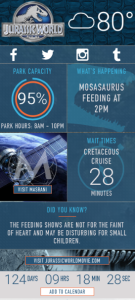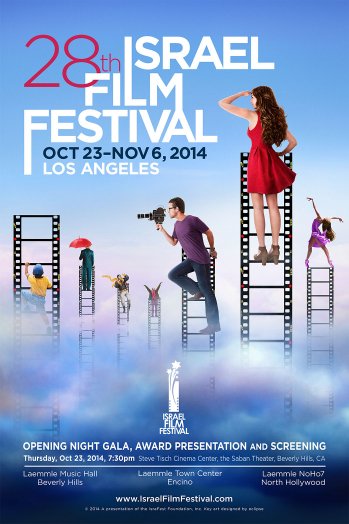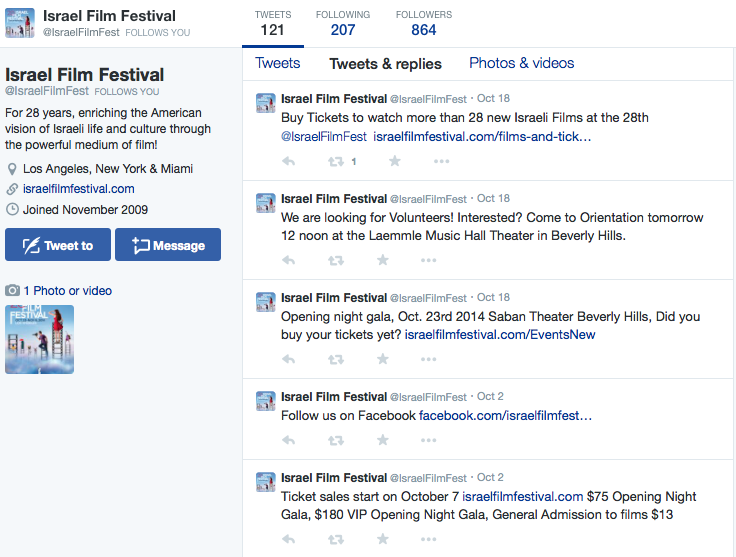Brands and Marketing

The Marvelous Mrs. Marketing–oops, I Meant “Maisel” (& more!)
0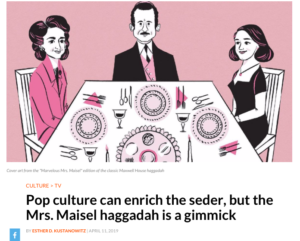 That’s right. I said it. I’m the grinch who stole Passover. I’m the “Marvelous Mrs. Maisel” fan who doesn’t want a Maisel-themed Haggadah for her Passover seder. But I do wish that when these religion-and-pop-culture mashups happen, that they do so in a way that enriches either the religious source material or the pop culture text, and this collector’s edition did neither–it was simply a marketing gimmick. The Maxwell House Haggadah is known for its accessible simplicity. And I can respect that, even if it’s not what I find meaningful during the Passover holiday. But I am the kind of person who likes to dive deep into culture and text, to look for meaning.
That’s right. I said it. I’m the grinch who stole Passover. I’m the “Marvelous Mrs. Maisel” fan who doesn’t want a Maisel-themed Haggadah for her Passover seder. But I do wish that when these religion-and-pop-culture mashups happen, that they do so in a way that enriches either the religious source material or the pop culture text, and this collector’s edition did neither–it was simply a marketing gimmick. The Maxwell House Haggadah is known for its accessible simplicity. And I can respect that, even if it’s not what I find meaningful during the Passover holiday. But I am the kind of person who likes to dive deep into culture and text, to look for meaning.
What might I have done instead? Try to look at the Maisel characters through a Passover lens. Take the Four Children: Wise, Wicked, Simple and Unable to Ask a Question…Midge Maisel (nee Weissman) spends years not knowing how to ask for what she wants, but then gets wise about it, rendering her wicked in the eyes of father, Abe, a wise man (phonetically, Weissman!) whose worldview is rigid and simple. Rose demands her daughter conform to a simpler life, but because she herself doesn’t know how to ask for what she wants, she flees her life (wicked?) and country to reconnect with an old path. And in the newest season, we find out that the son, living a life at a frequency that seemed much simpler than Midge’s, is using that simplicity as a cover for a complicated government life. Maisel characters–and people–are complicated.
For more about how I’d bring pop culture into the Four Children context, check out my latest in the J. And you can check out past pop culture/Passover pieces at my Haggadot.com author page (where you can make your own meaningful Haggadah!)
(Thanks for reading – will try to keep this space more updated in the future.)

Jurassic World: The Transmedia Story Begins
1If you watched the Super Bowl, you probably already saw the ad for Jurassic World, the next sure-to-be-a-blockbuster summer movie in a franchise that continues to ask the question, “if we rebuilt the park AGAIN…would it still be a disaster?” and adds the question, “if we created an even deadlier dinosaur than a T-Rex…would that create a safe theme park environment?” While I’m guessing the answer are “yes” and “no,” respectively, from the minute I hear the John Williams score, I’m on board.
But if you’re on the electrified paddock fence about contributing your movie ticket’s cost to creating a blockbuster, Jurassic World wants you: you might not be interested in another dino-disaster flick, but could they interest you in a relaxing trip to the Hilton Isla Nublar, to enjoy the family attractions of their theme park?
Of course, Isla Nublar isn’t a real place. But that hasn’t stopped Jurassic World from launching the story of the film – which isn’t out for another 4 months – through an impressively-detailed website that mimics the life and offerings of a real-life theme park. The site features restaurant menus at the park’s dining establishments, educational materials about the dinosaurs that visitors will encounter, and “live-cam” footage from the park. If you’re really looking for it can you find the link, in tiny print, that says “visit jurassicworldmovie.com.” And if you try to “book” one of their packages – which come in Standard, Family, Adrenaline, Romance and others, each built-out and better-programmed than some conferences I’ve been to – you will get re-routed to Fandango. Otherwise, you can go about your business fantasizing about your luxurious fake-cation.
Jurassic World is creating its narrative’s world through transmedia – creating content across multiple media, in support of a story that will exist or already does exist somewhere else (at least that’s my layperson’s explanation; see here for something “more official“).
Transmedia extends the story and enables more personalized access to the narrative than a one-directional film aimed at an audience in a darkened theater could, and expands the reach of that story using different tools in the storytelling toolkit. Whether it’s webisodes that tell you more about minor characters or deepen historical backstory for a TV show or a peek inside the diary or blog of a character who’s always depicted as scribbling in a notebook, transmedia is a reward for fans who want to know more and a tool to deepen their relationship to the show. It’s like backchannel chatter among those in the know. Sharing information can be a powerful thing that builds trust and investment, creating a proud cohort of evangelists who can represent your brand even when you’re on your lunch break.
It’s become trendy to talk about “storytelling” when it comes to branding. But the word “story” itself doesn’t mean what it classically used to. Now there’s the all-access story, the story-behind-the-story, the context for the story, the story-after-the-story.
The JurassicWorld.com website may still not convince you to see Jurassic World, the movie. But if it convinces you of one thing, let it persuade you to accept that people are learning to expect a narrative that is dynamic, expanding beyond its initially perceived limits. And the most successful brands and organizations will spend the time, creativity and money to build out the universe around the main story in a way that supports their core message, whether it’s donations or dinosaurs.

Social Media Case Study: Unsolicited Advice for the Israel Film Festival
0When I lived in New York, one of the focal points of my entertainment year was the Israel Film Festival. My friends and I, pre-Hulu, pre-Netflix, pre-much-of-anything-other-than-mainstream-modes-of-entertainment, eagerly anticipated the annual display of Jewiness-on-film meets Zionism, the Jewish geography and Hebrew immersion experience that was the Festival. We all knew when the Festival was happening, where it was happening and what was playing. I remember that most of the shows were sold out well in advance, because of the collective New York Israel-loving-and-missing community, many of us in our twenties. We planned outings, doing dinner or drinks first at a local bar or on several occasions, sinking into New York cliche with frozen hot chocolate at Serendipity, which had the convenience of being nearby the theater.
And all of that was before social media.
Since I moved to LA, I’ve either been out of town for the IFF (my fault, but usually because I’m in Israel), or have been in town but have been unaware that it’s happening. This doesn’t seem possible, as I spend most of the day online and connected to the Jewish world. I follow the IFF on Twitter, and subscribe to their FB page, as well as email blasts from the Jewish Journal and the IAC. This year, one of my friends posted about it on Facebook. But if not for that, I might have woken up someday next week and learned that I had missed it yet again.
Theoretically, in this age of hyper-connectivity, I should have been overwhelmed with communications regarding the IFF, both in advance and once it was underway. So why wasn’t I? Part of the problem is that communications are overwhelming generally – since I rarely pick up a copy of the Jewish Journal and read only selected articles online, it’s not the mainstream media that’s the problem as much as it is the evolving way we consume that information. And it might be, in part, because their social media presence is so minimal and they are failing to mobilize the audience (and their sponsors) as brand ambassadors and PR agents.
Because Facebook is an inexplicable mystery when it comes to assessing the potential for organic reach without advertising (and because they should be advertising to LA Jews and don’t seem to be), let’s take a look at the Twitter account for @israelfilmfest.
Their account, since November 2009, has tweeted 121 times. They have under 1000 followers. Most of the “people” they’re “following” on Twitter aren’t people at all: they’re other Film Festivals (who are not likely to share, retweet or publicize the IFF’s efforts) and organizations (some partners, who should be sharing/retweeting/publicizing, but don’t seem to be). And – most disturbingly – only have tweeted 5 times in the month of October, precisely when tweets should have been, if not fast and furious, then laden with information, tempting offers and tidbits about the festival’s films. The website links to a few pieces about the Festival, but imagine the reach of those pieces expanded by social media…
This advice is unsolicited. But because I love the Festival, I’m sharing some tips about how to do it better next year (or at the other two outings of the festival, upcoming in Miami and New York….but don’t ask me when those are or were, since that info doesn’t seem to be on the IFF website).
1. Use your assets in promoting the festival. The filmmakers. The content of their work. Their actors. People in LA who are Israeli or support Israeli culture. Local kosher/Israeli establishments. Festival partners. Organizations who aren’t financial sponsors, but could be content partners. And the organizers should have shot wide in terms of the angles that could be explored for coverage. For instance:
- People who are in the know about Israeli music get giddy at the fact that Meir Fenigstein founded and runs the Festival, it’s like being in the same room with one of the Beatles. Why isn’t there an article about Poogy/Kaveret, or about the music of Israeli films?
- Fenigstein told a story at the screening of “The Go-Go Boys” about Menahem Golan’s role in suggesting and sponsoring the first IFF. Why wasn’t that a first-person piece (or an interview) in the Jewish Journal, Variety, THR, The Writer’s Guild, the Academy of Motion Picture Arts & Sciences, or EW?
- Cannon Films, the Golan/Globus production company that became huge in the 80s and is the focus of The Go-Go Boys,” producing Death Wish, Bloodsport & Breakin’, must have inspired dozens of filmmakers (in addition to Eli Roth, who is featured in the film). Maybe pitch Quentin Tarantino on writing something about his favorite Cannon Films outing, or invite Eli Roth to introduce the film at the Festival? (They may have, but these are the types of ideas I mea when I say “shooting wide…” in regard to PR.)
2. Enhance your social media presence. Ideally, hire someone (or designate a web-savvy volunteer) to coordinate a multi prong social media approach, including (at minimum) Facebook, Twitter & Instagram. But I know sometimes Jewish nonprofits can’t allocate those funds, in which case less ideal but still a plan, hire a consultant to create a plan for you to implement before during and after the festival. And that’s #3…
3. Create a content plan, including a commitment to Tweeting regularly leading up to and during the festival. In addition to varying the types of content posted (trivia, Q&A about the festival or its films, short video clips, shoutouts to filmmakers, links to purchase etc), this content plan should also clearly identify the goals of each week’s social media outreach. Which week will be primarily about promotion and identifying potential partners/sponsors? Which week will be about getting people in the seats? Which week will be about celebrating the people who come and the energy on-site? (That there are NO PHOTOS on the Photos tab on the website as of November 2 – a week into the festival with almost a week to go – is not a good sign.)
Keeping Twitter current and active on its own (or even using magical Facbeook advertising) isn’t necessarily going to sell out the festival. But today, there are so many (free or mostly free) tools that are available – why not use them?
(If the folks at the IFF want help with this next year, they can feel free to be in touch. I’ll give them a decent rate, I promise. :))
Want more posts like this one? Consider joining my new mailing list. No spam, no overwhelming emails, just the occasional conversation starter/act of self-promotion. 🙂 Sign up here…

Video Workshop: “Leadership in the Digital Age”
0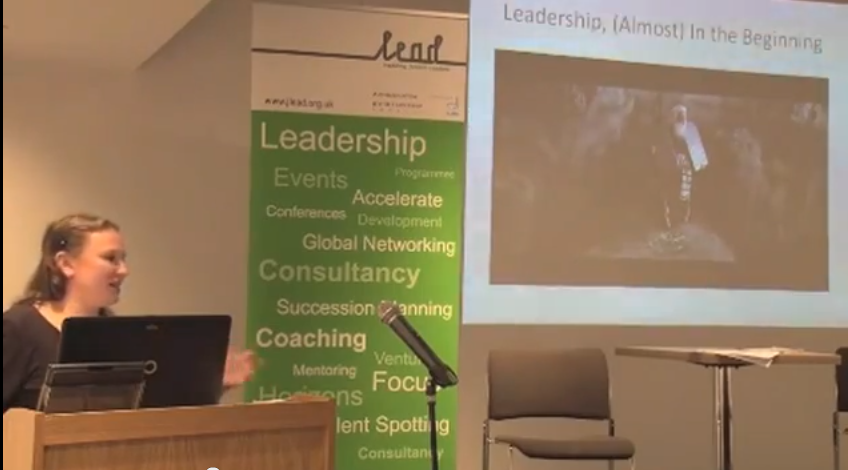 In May, I was invited to London to speak as part of the Jewish Leadership Council’s Lead Division’s newest initiative, Leading In which was created in response to the desire and need for more leadership skills training, expressed by alumni of Lead’s programmes as well as employers within the community. The JLC, in a blog post about the program, explained:
In May, I was invited to London to speak as part of the Jewish Leadership Council’s Lead Division’s newest initiative, Leading In which was created in response to the desire and need for more leadership skills training, expressed by alumni of Lead’s programmes as well as employers within the community. The JLC, in a blog post about the program, explained:
We believe that Jewish communal leaders need both a deep understanding and knowledge of the UK Jewish Community as well as a core range of leadership skills. Leading In consists of regular bi-monthly evening sessions, open to all who are in a leadership position in the community, both lay and professional. Each session will include a leadership skills based session (a choice of three with the option to participate in a fundraising series over several sessions), an opportunity to network and a masterclass with an inspirational, visionary leader.
The event, held at the London Jewish Museum, was attended by 60 lay and professional leaders from more than 30 Jewish communal organizations. Debbie Klein, chair of JW3 (the about-to-launch Jewish Community Centre), gave the opening keynote discussing leadership tips, and participants chose from workshops like, “Inside the mind of a leader” with Jeff Wolfin, “Fundraising” with Jeff Shear (the second in the series), and my session, “Leadership in the Digital Age: Conversing, Commenting and Creating Meaningful Relationships” (available in its entirety – 1 hour, 22 minutes – below.
“Leadership in the Digital Age” – Esther Kustanowitz, May 2013

Virgin Atlantic’s Snowpocalypse Social Media #Fail
1When a blizzard prompted the cancellation of hundreds of flights on December 26 of last year, I was scheduled to be on VS004 from JFK to London. My Virgin Atlantic flight – which had been cancelled on the 19th due to a blizzard at Heathrow and rescheduled for the 26th at 6:05pm – was again cancelled after we sat on the plane for two hours because of a blizzard at JFK, was rescheduled for 6:05pm the 27th, then delayed to 7:30, then to a boarding time of 8:15 that didn’t happen, and eventually, after great protest from the passengers, finally took off after midnight on the 28th. During the entire experience, Virgin Atlantic continued to answer questions on its @virginatlantic Twitter account – except about our flight. There was no “stay tuned,” no “sorry we don’t have more information right now,” just silence. This is unacceptable in a social media world.
Nearly a month later now, Virgin Atlantic still denies that passengers were due any compensation for the experience, even as JetBlue once again proves its VIP status by giving their stranded passengers 10,000 points, scoring customer satisfaction points among its inconvenienced passengers. When it comes to all-star VIP customer treatment and stellar social media response, JetBlue turns around their bad situation, resulting in another social media win. In other words, JetBlue was able to take a blizzard and turn it into snowcones.
What’s the problem? Why won’t Virgin Atlantic make any compensation to the 250 of us who were on VS 004? According to USA Today, Virgin Atlantic (via spokesperson Greg Dawson) claims that “monetary compensation is not due” to the people on our flight – who “had to sleep in the airport terminal because all hotels nearby were booked” – because the snowstorm was an “extraordinary occurrence.” (The Virgin Atlantic staff also told us that the hotels they were offering us were two hours away in Long Island, and that buses would take too long to reach us, collect us and turn around and go back to Long Island.)
Travel writer and the main Twitter voice of our Virgin Atlantic experience Jason Cochran hasn’t given up on the idea of compensation, and continues to battle the customer relations and public relations departments via email.
But apparently, Virgin’s petulant behavior extends far beyond our particular flight – according to Bnet’s Brett Snyder, “Virgin Atlantic has decided it won’t pay Heathrow Airport’s owner BAA anything until an inquiry into last month’s days-long shutdown is completed. Virgin Atlantic is acting like an impatient child here, and runs the risk of making relations with its most important airport even worse.”
This preposterous experience just doesn’t seem to end. And least of all for writers. Because Jason is still on this situation – it’s his job to be. And as for me, while I’m not spending every day fighting about it, I definitely have more to say. Because all the elements of this experience combined into something resembling a psychological experiment in how far people’s patience can be stretched before someone cracks and goes postal. And while a Tweet here and there might not have alleviated our discomfort as we lay down for 40 minutes’ rest on the cold floor of JFK Airport, Virgin Atlantic should have been using its social media presence to reassure us, to apologize to us, and to make us feel accompanied on our difficult travel. That kind of attention could really have helped us feel like we hadn’t been quite so abandoned.
Here endeth the lesson. Except not quite, because Virgin Atlantic hasn’t learned anything.

Twitter and the College Student Population
0 At the recent JFNA General Assembly in New Orleans, I was asked to speak to a group of student journalists for a program called “Do the Write Thing.” The program features speakers from the world of Jewish leadership as well as from Jewish journalism – the session that I co-headlined (with the Jewish Agency’s Florence Broder) was about social media’s role in today’s Jewish journalism. While all of the students understood and used Facebook, and a few of them were familiar with blogs and the concept of blogging, when it came to Twitter, many of them were clueless. One of the attendees, a writer for the Binghamton University Pipe Dream, wrote a piece for that paper and noted that a junior, double-majoring in history and philosophy, politics and law, “stared blankly when asked about Twitter. ‘I barely know what it is,’ she said. ‘Something about birds?’”
At the recent JFNA General Assembly in New Orleans, I was asked to speak to a group of student journalists for a program called “Do the Write Thing.” The program features speakers from the world of Jewish leadership as well as from Jewish journalism – the session that I co-headlined (with the Jewish Agency’s Florence Broder) was about social media’s role in today’s Jewish journalism. While all of the students understood and used Facebook, and a few of them were familiar with blogs and the concept of blogging, when it came to Twitter, many of them were clueless. One of the attendees, a writer for the Binghamton University Pipe Dream, wrote a piece for that paper and noted that a junior, double-majoring in history and philosophy, politics and law, “stared blankly when asked about Twitter. ‘I barely know what it is,’ she said. ‘Something about birds?’”
While the students in the room at DTWT weren’t quite at that level of Twitter illiteracy, their lack of facility – and maybe even interest? – in the tool known as Twitter illustrates a point. Not every person who is young is active in all forms of social media. And while Facebook may be an exception, there is no one social media tool that is being used actively by all young people.
What organizations can take away from this is that although young people are involved in social media, social media is not the universal tool through which a project or organization can reach all young people. Today’s organizations must be educated about the tools that are out there, and know how to use them – but organizations need to adopt flexibility in creating their social media strategies, matching the available time and energy of their staffs to the likely payoff in each of the markets for tools like Twitter, Facebook, LinkedIn, etc.
Social media consultants can help, but so can members of your target demo. Use the tools that are out there – search Twitter and Facebook for conversations relevant to your product or program. And convene focus groups of people in the relevant demo – ask them how they prefer to get information and how they use these tools. Once you know where the people you want to reach dwell, you can know how to knock on the door.
